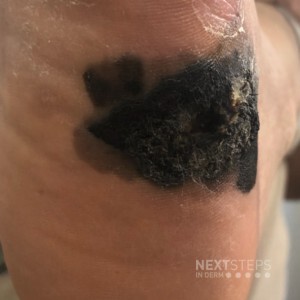
The correct answer is D. CDKN2A.
Malignant melanoma is considered the most lethal skin cancer if it is not detected and treated during its early stages. About 10% of melanoma patients report a family history of melanoma; however, individuals with features of true hereditary melanoma (ie, unilateral lineage, multigenerational, multiple primary lesions, and early onset of disease) are in fact quite rare. Although many new loci have been implicated in hereditary melanoma, CDKN2A mutations remain the most common. Familial melanoma in the presence of multiple atypical nevi should raise suspicion for a germline CDKN2A mutation. These patients have a high risk of developing multiple primary melanomas and internal organ malignancies, especially pancreatic cancer; therefore, a multidisciplinary approach is necessary in many cases. The value of dermoscopic examination and total body photography performed at regular intervals has been suggested by a number of studies, and should therefore be considered for these patients and their first-degree relatives. In addition, genetic counseling with the possibility of testing can be a valuable adjunct for familial melanoma patients. This must be performed with care, however, and only by qualified individuals trained in cancer risk analysis.
Recent advances in cancer genomics have enabled the discovery of many cancer-predisposing genes that are being used to classify new familial melanoma/cancer syndromes. In addition to CDKN2A and CDK4, germline variants in TERT, MITF, and BAP1 have been added to the list of genes harboring melanoma-predisposing mutations. Pancreatic cancer is not a typical feature of TERT, MITF, and BAP1 hereditary melanoma syndromes. Germline PTCH mutations are associated with basal cell nevus syndrome (aka Gorlin syndrome).
References:
PMID: 26892651; PMID: 26892650
